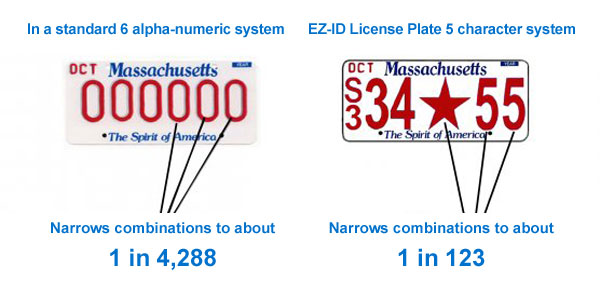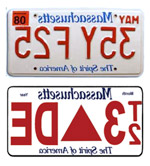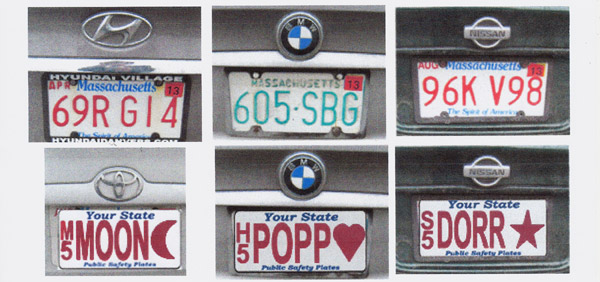EZ-ID uses universally recognizable symbols to increase chance of witnesses identifying characters on a license plate during a crisis.
The EZ-ID license plate format uses universally recognizable symbols, such as a star, heart, diamond, square, circle, triangle, etc., along with alpha numeric characters, to give a graphic that even young children can recognize, remember and report. Each general issue plate would have one universally recognized symbol, along with other numbers and letters, making up the individual’s plate registration number. EZ-ID would not displace specialty plates, low number plates or vanity plates, as these are already more recognizable.

Police and Registry systems are already equipped to enter these new symbols.
In police and registry systems, the EZ-ID format utilizes a small letter over number code, to the left of the individual’s main plate registration number. This is similar to the letter over letter code used on current specialty plates such as the Boston Red Sox plates, which have an “R” over an “S.” With EZ-ID, an “S” (the letter designates the symbol code, such as an “S” for star, “D” for diamond, “H” for a heart, etc.) over a “3” (the number tells the position code of the symbol in the plate’s registration numbering sequence) would mean that there is a star in the 3rd position in the individual’s plate registration number. The Registry and Police can input the EZ-ID code through any standard computer keyboard, just as they would for the Red Sox plates or any other specialty plates.

CJIS (Criminal Justice Information System) is a division of the FBI, with license plate oversight authority for the USA. After a review of EZ-ID, the CJIS representative stated that EZ-ID is a “good idea” which “would work across the entire country”.
 Symbols are mirror images of themselves.
Symbols are mirror images of themselves.
The symbol can also be recognized through a rear view mirror, and by the large segment of the population with dyslexia, even when reversed. Letters and numbers, the only characters on general issue license plates, become illegible when reversed.
Only characters (including the symbol) are needed for many states, not the 6 and 7 characters currently used.
Depending on the number of symbols which a state chooses to use, many states would have a enough mathematical combinations to only require 4 characters (including the symbol) on their license plates. Since the symbol can occupy any position on the license plate…it is almost as if extending the alphabet, and therefore creating 2-3X, or more, the number of mathematical combinations, depending on how many symbols are used.
When additional combinations are needed, the Double Character Format (DCF) can be used, which doubles a number or letter, essentially making it readily identifiable like a 4-Character Format.

Words or “NEW Words” (Identifiable letter combinations) can be used to give 100% instant identification..

Fewer characters to remember. Fonts can be made larger and easier to see.
Identification of Manufactuer Logos:
Most vehicle manufacturers locate their company logos just above the license plates. The manufacturers recognized the the human eye is drawn to the license plate, therefore they have strategically located their advertising there. This gives an additional identification marker for people to identify and report more information about the vehicle, further reducing the search.

